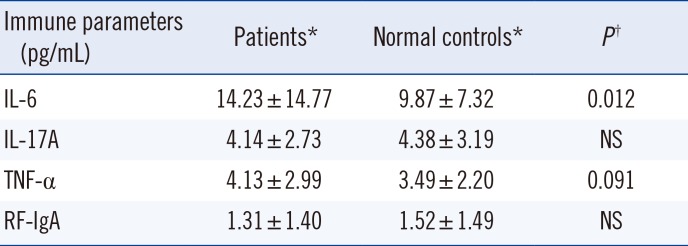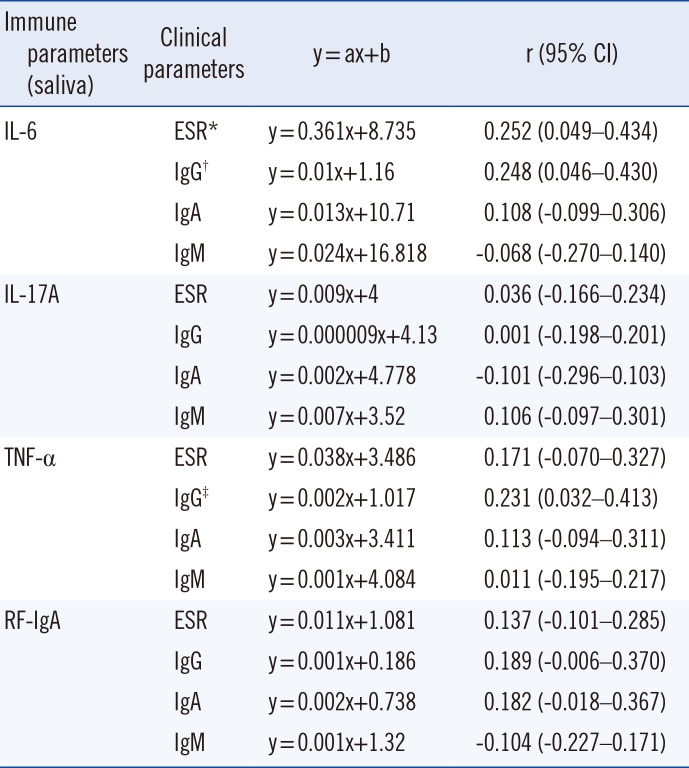1. Ramos-Casals M, Tzioufas A, Font J. Primary Sjogren's syndrome: new clinical and therapeutic concepts. Ann Rheum Dis. 2005; 64:347–354. PMID:
15498797.
2. Yu KH, See LC, Kuo CF, Chou IJ, Chou MJ. Prevalence and incidence in patients with autoimmune rheumatic diseases: a nationwide population-based study in Taiwan. Arthritis Care Res (Hoboken). 2013; 65:244–250. PMID:
22899470.
3. Cobb BL, Lessard CJ, Harley JB, Moser KL. Genes and Sjogren's syndrome. Rheum Dis Clin North Am. 2008; 34:847–868. PMID:
18984408.
4. Lessard CJ, Li H, Adrianto I, Ice JA, Rasmussen A, Grundahl KM, et al. Variants at multiple loci implicated in both innate and adaptive immune responses are associated with Sjogren's syndrome. Nat Genet. 2013; 45:1284–1292. PMID:
24097067.
5. Li Y, Zhang K, Chen H, Sun F, Xu J, Wu Z, et al. A genome-wide association study in Han Chinese identifies a susceptibility locus for primary Sjogren's syndrome at 7q11.23. Nat Genet. 2013; 45:1361–1365. PMID:
24097066.
6. Hermann E, Vogt P, Muller W. Rheumatoid factors of immunoglobulin classes IgA, IgG and IgM: methods of determination and clinical value. Schweiz Med Wochenschr. 1986; 116:1290–1297. PMID:
3775335.
7. Herrmann D, Jager L, Hein G, Henzgen M, Schlenvoigt G. IgE rheumatoid factor. Occurrence and diagnostic importance in comparison with IgM rheumatoid factor and circulating immune complexes. J Investig Allergol Clin Immunol. 1991; 1:302–307.
8. Banchuin N, Janyapoon K, Sarntivijai S, Parivisutt L. Re-evaluation of ELISA and latex agglutination test for rheumatoid factor detection in the diagnosis of rheumatoid arthritis. Asian Pac J Allergy Immunol. 1992; 10:47–54. PMID:
1418183.
9. Martel C, Gondran G, Launay D, Lalloue F, Palat S, Lambert M, et al. Active immunological profile is associated with systemic Sjogren's syndrome. J Clin Immunol. 2011; 31:840–847. PMID:
21744183.
10. Malladi AS, Sack KE, Shiboski SC, Baer AN, Banushree R, Dong Y, et al. Primary Sjogren's syndrome as a systemic disease: a study of participants enrolled in an international Sjogren's syndrome registry. Arthritis Care Res (Hoboken). 2012; 64:911–918. PMID:
22238244.
11. Seror R, Ravaud P, Bowman SJ, Baron G, Tzioufas A, Theander E, et al. EULAR Sjogren's syndrome disease activity index: development of a consensus systemic disease activity index for primary Sjogren's syndrome. Ann Rheum Dis. 2010; 69:1103–1109. PMID:
19561361.
12. Ramos-Casals M, Font J, Garcia-Carrasco M, Brito MP, Rosas J, Calvo-Alen J, et al. Primary Sjogren syndrome: hematologic patterns of disease expression. Medicine. 2002; 81:281–292. PMID:
12169883.
13. Quartuccio L, Isola M, Baldini C, Priori R, Bartoloni E, Carubbi F, et al. Clinical and biological differences between cryoglobulinaemic and hypergammaglobulinaemic purpura in primary Sjogren's syndrome: results of a large multicentre study. Scand J Rheumatol. 2015; 44:36–41. PMID:
25268749.
14. Ohyama K, Moriyama M, Hayashida JN, Tanaka A, Maehara T, Ieda S, et al. Saliva as a potential tool for diagnosis of dry mouth including Sjogren's syndrome. Oral Dis. 2015; 21:224–231. PMID:
24750447.
15. Nguyen CQ, Hu MH, Li Y, Stewart C, Peck AB. Salivary gland tissue expression of interleukin-23 and interleukin-17 in Sjogren's syndrome: findings in humans and mice. Arthritis Rheum. 2008; 58:734–743. PMID:
18311793.
16. Moriyama M, Hayashida JN, Toyoshima T, Ohyama Y, Shinozaki S, Tanaka A, et al. Cytokine/chemokine profiles contribute to understanding the pathogenesis and diagnosis of primary Sjogren's syndrome. Clin Exp Immunol. 2012; 169:17–26. PMID:
22670774.
17. Vitali C, Bombardieri S, Jonsson R, Moutsopoulos HM, Alexander EL, Carsons SE, et al. Classification criteria for Sjogren's syndrome: a revised version of the European criteria proposed by the American-European Consensus Group. Ann Rheum Dis. 2002; 61:554–558. PMID:
12006334.
18. Roescher N, Tak PP, Illei GG. Cytokines in Sjogren's syndrome. Oral Dis. 2009; 15:519–526. PMID:
19519622.
19. Benchabane S, Boudjelida A, Toumi R, Belguendouz H, Youinou P, Touil-Boukoffa C. A case for IL-6, IL-17A, and nitric oxide in the pathophysiology of Sjogren's syndrome. Int J Immunopathol Pharmacol. 2016; 29:386–397. PMID:
27207443.
20. Fox RI, Kang HI, Ando D, Abrams J, Pisa E. Cytokine mRNA expression in salivary gland biopsies of Sjogren's syndrome. J Immunol. 1994; 152:5532–5539. PMID:
8189070.
21. Streckfus C, Bigler L, Navazesh M, Al-Hashimi I. Cytokine concentrations in stimulated whole saliva among patients with primary Sjögren's syndrome, secondary Sjögren's syndrome, and patients with primary Sjögren's syndrome receiving varying doses of interferon for symptomatic treatment of the condition: a preliminary study. Clin Oral Investig. 2001; 5:133–135.
22. Zhang LW, Cong X, Zhang Y, Wei T, Su YC, Serrao AC, et al. Interleukin-17 impairs salivary tight junction integrity in Sjogren's syndrome. J Dent Res. 2016; 95:784–792. PMID:
26933138.
23. Nguyen CQ, Yin H, Lee BH, Carcamo WC, Chiorini JA, Peck AB. Pathogenic effect of interleukin-17A in induction of Sjogren's syndrome-like disease using adenovirus-mediated gene transfer. Arthritis Res Ther. 2010; 12:R220. PMID:
21182786.
24. Lin X, Rui K, Deng J, Tian J, Wang X, Wang S, et al. Th17 cells play a critical role in the development of experimental Sjogren's syndrome. Ann Rheum Dis. 2015; 74:1302–1310. PMID:
24573745.
25. Zhang LW, Zhou PR, Wei P, Cong X, Wu LL, Hua H. Expression of interleukin-17 in primary Sjogren's syndrome and the correlation with disease severity: a systematic review and meta-analysis. Scand J Immunol. 2018; 87:e12649. PMID:
29476557.
26. Azuma M, Aota K, Tamatani T, Motegi K, Yamashita T, Ashida Y, et al. Suppression of tumor necrosis factor alpha-induced matrix metalloproteinase 9 production in human salivary gland acinar cells by cepharanthine occurs via down-regulation of nuclear factor kappaB: a possible therapeutic agent for preventing the destruction of the acinar structure in the salivary glands of Sjogren's syndrome patients. Arthritis Rheum. 2002; 46:1585–1594. PMID:
12115190.
27. Zhou J, Kawai T, Yu Q. Pathogenic role of endogenous TNF-alpha in the development of Sjogren's-like sialadenitis and secretory dysfunction in non-obese diabetic mice. Lab Invest. 2017; 97:458–467. PMID:
28067896.
28. Kang EH, Lee YJ, Hyon JY, Yun PY, Song YW. Salivary cytokine profiles in primary Sjogren's syndrome differ from those in non-Sjogren sicca in terms of TNF-alpha levels and Th-1/Th-2 ratios. Clin Exp Rheumatol. 2011; 29:970–976. PMID:
22132900.
29. Aota K, Azuma M. Targeting TNF-alpha suppresses the production of MMP-9 in human salivary gland cells. Arch Oral Biol. 2013; 58:1761–1768. PMID:
24200302.
30. Mariette X, Ravaud P, Steinfeld S, Baron G, Goetz J, Hachulla E, et al. Inefficacy of infliximab in primary Sjogren's syndrome: results of the randomized, controlled Trial of Remicade in Primary Sjogren's Syndrome (TRIPSS). Arthritis Rheum. 2004; 50:1270–1276. PMID:
15077311.
31. Fauchais AL, Ouattara B, Gondran G, Lalloue F, Petit D, Ly K, et al. Articular manifestations in primary Sjogren's syndrome: clinical significance and prognosis of 188 patients. Rheumatology. 2010; 49:1164–1172. PMID:
20299380.
32. Markusse HM, Otten HG, Vroom TM, Smeets TJ, Fokkens N, Breedveld FC. Rheumatoid factor isotypes in serum and salivary fluid of patients with primary Sjogren's syndrome. Clin Immunol Immunopathol. 1993; 66:26–32. PMID:
8440071.






 PDF
PDF ePub
ePub Citation
Citation Print
Print



 XML Download
XML Download